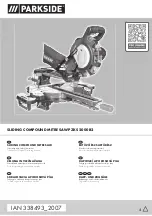
6
GB
g) Inspect your workpiece before cutting. If the
workpiece is bowed or warped, clamp it with
the outside bowed face toward the fence. Al-
ways make certain that there is no gap be-
tween the workpiece, fence and table along
the line of the cut.
Bent or warped workpieces can
twist or shift and may cause binding on the spinning saw
blade while cutting. There should be no nails or foreign
objects in the workpiece.
h) Do not use the saw until the table is clear of all
tools, wood scraps, etc., except for the work-
piece.
Small debris or loose pieces of wood or other
objects that contact the revolving blade can be thrown
with high speed.
i)
Cut only one workpiece at a time.
Stacked multi-
ple workpieces cannot be adequately clamped or braced
and may bind on the blade or shift during cutting.
j)
Ensure the mitre saw is mounted or placed on
a level, firm work surface before use.
A level and
firm work surface reduces the risk of the mitre saw becom-
ing unstable.
k) Plan your work. Every time you change the bev-
el or mitre angle setting, make sure the adjust-
able fence is set correctly to support the work-
piece and will not interfere with the blade or
the guarding system.
Without turning the tool “ON”
and with no workpiece on the table, move the saw blade
through a complete simulated cut to assure there will be no
interference or danger of cutting the fence.
l)
Provide adequate support such as table exten-
sions, saw horses, etc. for a workpiece that is
wider or longer than the table top.
Workpieces
longer or wider than the mitre saw table can tip if not
securely supported. If the cut-off piece or workpiece tips,
it can lift the lower guard or be thrown by the spinning
blade.
m) Do not use another person as a substitute for
a table extension or as additional support.
Un-
stable support for the workpiece can cause the blade to
bind or the workpiece to shift during the cutting operation
pulling you and the helper into the spinning blade.
n)
The cut-off piece must not be jammed or
pressed by any means against the spinning
saw blade.
If confined, i.e. using length stops, the cut-
off piece could get wedged against the blade and thrown
violently.
o) Always use a clamp or a fixture designed to
properly support round material such as rods
or tubing.
Rods have a tendency to roll while being cut,
causing the blade to “bite” and pull the work with your
hand into the blade.
p) Let the blade reach full speed before contact-
ing the workpiece.
This will reduce the risk of the
workpiece being thrown.
q) If the workpiece or blade becomes jammed,
turn the mitre saw off. Wait for all moving
parts to stop and disconnect the plug from
the power source and/or remove the battery
pack. Then work to free the jammed material.
Continued sawing with a jammed workpiece could cause
loss of control or damage to the mitre saw.
r) After finishing the cut, release the switch, hold
the saw head down and wait for the blade to
stop before removing the cut-off piece.
Reaching
with your hand near the coasting blade is dangerous.
s) Hold the handle firmly when making an incom-
plete cut or when releasing the switch before
the saw head is completely in the down posi-
tion.
The braking action of the saw may cause the saw
head to be suddenly pulled downward, causing a risk of
injury.
Safety Instructions for the handling of saw blades
1. Do not use damaged or deformed saw blades.
2. Do not use any insertion tools with cracks. Sort out cracked
insertion tools. Repairs are not permitted.
3. Do not use saw blades made of high speed steel.
4. Check the condition of the saw blades before using the
crosscut, drag and mitre saw.
5. Make sure that a suitable saw blade for the material to
be cut is selected.
6. Only use saw blades recommended by the manufacturer.
Saw blades designed to cut wood and similar materials
must comply with EN 847-1.
7. Do not use saw blades made of high-speed alloy steel
(HSS steel).
8. Only use saw blades for which the maximum permissible
speed is not lower than the maximum spindle speed of the
crosscut, drag and mitre saw and which are suitable for
the material to be cut.
9. Observe the saw blade direction of rotation.
10. Only insertion the saw blade if you have mastered their
use.
11. Observe the maximum speed. The maximum speed speci-
fied on the insertion tool may not be exceeded. If speci-
fied, observe the speed range.
12. Clean grease, oil and water off of the clamping surfaces.
13. Do not use any loose reducing rings or bushes for the re-
ducing of holes on saw blades.
14. Make sure that fixed reducer rings for securing the inser-
tion tool have the same diameter and have at least 1/3 of
the cutting diameter.
15. Make sure that fixed reducer rings are parallel to each
other.
16. Handle insertion tool with caution. They are ideally stored
in the originally package or special containers. Wear
protective gloves in order to improve grip and to further
reduce the risk of injury.
17. Prior to the use of insertion tools, make sure that all protec-
tive devices are properly fastened.
18. Prior to use, make sure that the insertion tool meets the
technical requirements of this electric tool and is properly
fastened.
19. Only use the supplied saw blade for cutting wood, never
for the processing of metals.
20. Only use saw blade diameters in accordance with the
markings on the saw.
21. Use additional workpiece supports, if required for work-
piece stability.
22. Workpiece support extensions must always be secured
and used during work.


























